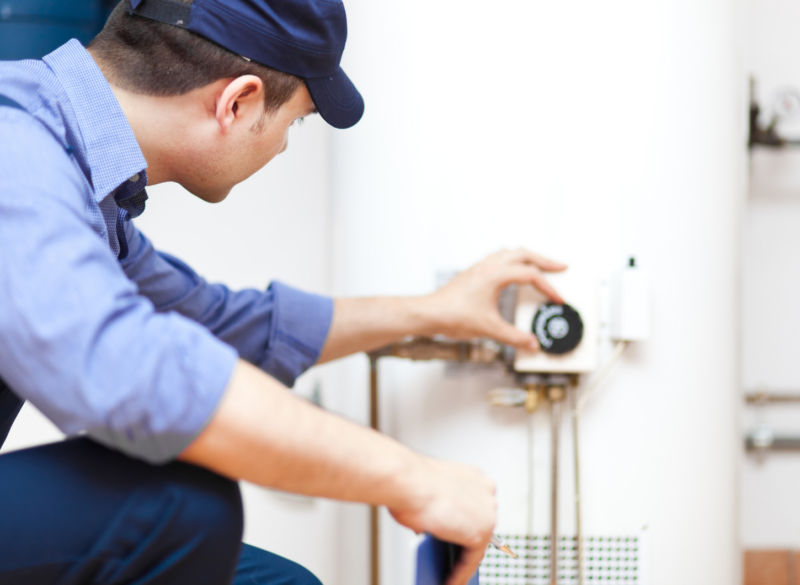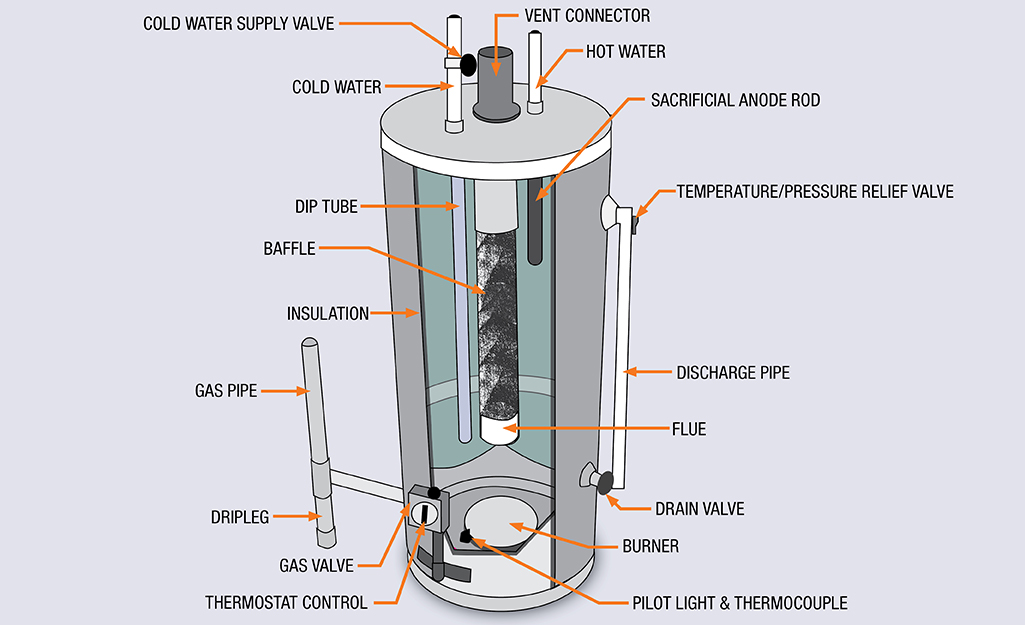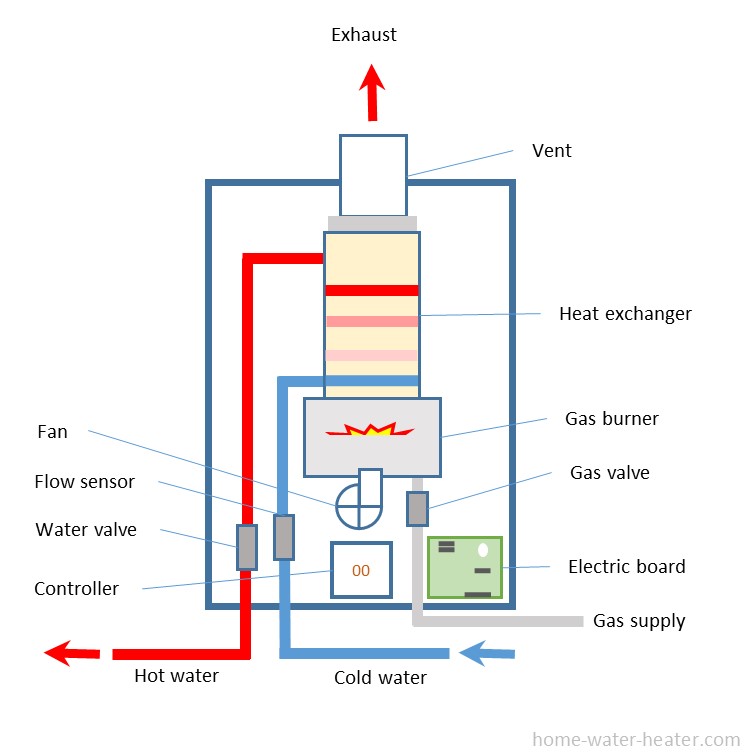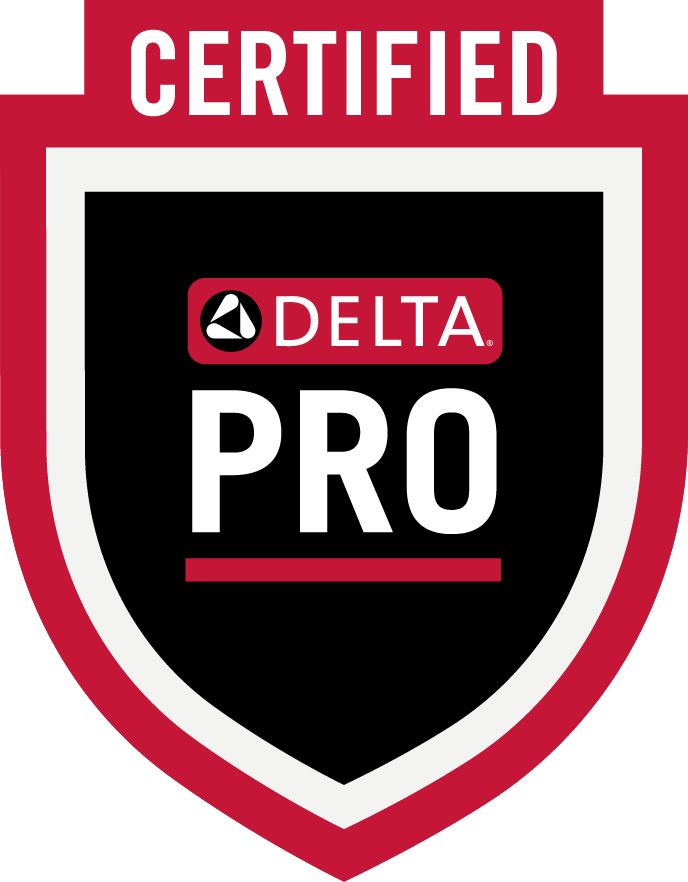
Water heaters are essential to modern life. Many people can’t even imagine what life would be like with only cold water! Since the late 1800’s water heaters have improved our lives drastically, but they come with their plumbing issues as well. Here is everything you need to know about water heaters, their components, their problems, and how water heater plumbers can fix them.

Traditional water heaters have been heating water in homes since the late 1800’s. Water heaters serve a great purpose for mankind and are known to have played a part in transforming modern society. With that being said, water heaters have many parts and elements, some of which can break at any given time. Things like corrosion and sediment build-up can cause water heaters to fail over time and servicing them regularly is a great idea. If you have a water heater problem in Orange County, contact us today for water heater repair service. Here are some of the common parts in your water heater.
The vacuum or air pressure switch in a water heater measures the air pressure created by a blower and ensures that the air pressure is correct. When air pressure is in the correct range, the switch closes a circuit that can trigger a function. On a water heater, the air pressure switch is a safety device to prevent possible explosion. If air pressure is not sufficient in certain range between 80-120 PSI, the air pressure switch will not close circuit to gas control valve and water heater will not turn on gas to burner. This ensures full of fuel and prevents explosions.
Anode rods are essential to the function of your water heater. An Anode is a metal rod that corrodes instead of the water heater tank itself. An Anode Rod helps keep your hot water heater working properly by attracting or deflecting corrosive elements in the water. Anodes are typically made out of aluminum, zinc, magnesium or some combination thereof.
Power vent water heaters use a blower to push the fumes out of your home, which requires more electricity than that needed by direct vent water heaters. The extra power required can cause your electric bill to increase. Before you make a decision about buying either water heater type, learn more about each and decide for yourself if you can afford and need a power vent water heater.
Many water heaters include a diagonal tube, or “dip tube”, that must be installed in the cold water inlet to direct the water into the tank. Dip tubes are usually made of flexible plastic and can be made with one or more coils to help lower their height. Dip tubes should be free of kinks and not look worn or brittle.
Every water tank and tankless has a drain valve that’s used for draining sediment from the inside of the tank. Water builds up in the tank which causes a float inside the housing to rise once reaching a pre-set level it will trigger your drain to open.
The water heater is equipped with a combination thermostat and high limit Energy-Cut-Off control (ECO) that is located above the heating element in contact with the tank surface. If for any reason the water temperature becomes excessively high, the high limit control (ECO) breaks the power circuit to the heating element.
Electric timers are commonly used to control water heater functions. Electric timers are not always necessary, but they can definitely add convenience. Electric timer models vary depending on the manufacturer and model.
Water heater expansion tanks are designed to provide additional water capacity needed due to thermal expansion as heated water enters the tank through incoming pipes. Thermal expansion occurs when heated fluid increases in volume as it becomes hotter.
Modern gas water heaters have a Flame Arrestor (FVIR) to help prevent the ignition of flammable gas vapors that may be in the air from your water heater.
Gas burner assembly or gas supply is an important element in the water heater. It consists of a thermocouple, main orifice, main gas supply tube, pilot burner (or pilot lights), pilot orifice and pilot burner gas supply.
In traditional water heaters, gas valves control the pilot light, and in turn, the water temperature. When a water heater turns on, the button on the valve is pressed and a small amount of gas is sent to the pilot head.
The Water Heater Heating Element is an apparatus meant to generate warmth to the water inside a tank. It works by using electricity as its source to heat up or activate the device that brings about the increase of temperature in the water.
A Mixing valve, also known as a water heater mixing valve, is an electronically-controlled device that allows the user to preset the desired temperature of their domestic hot water. It can be thought of as two or three-way valves in one.
A power vent water heater is not hooked up to your home’s chimney. Water heaters with a power vent exhaust their combustion products horizontally and vents them through a horizontal pipe that leads out of the house, which makes them especially good for homes without an existing chimney or those located in hurricane-prone regions.
Hot water recirculating pump is installed on your hot water heater. This hot water recirculating pump sends hot water to hot taps and showers whenever hot is turned on without waiting for the hot water to reach the faucet.
Water heaters are household appliances that serve as a major convenience. Water heaters store up to 30-50 gallons of water, which is heated to a previously set temperature, then stored until you need to use it.
The TCO (Temporary Certificate of Occupancy) is not a final inspection, but it does allow occupancy of the building. Only portions of the building (like one room) can be occupied during the TCO if the TCO is for part of a whole or multi-unit building.
A water heater thermostat is a device that sits on top of your water heater and regulates the water temperature. Most water heaters have two main points to control water temperature. One is the pilot light, and the other is a water heater thermostat.
TPR valves relieve the excessive pressure that may build up in water heating systems and other tanks. TPR valves open when the temperature or pressure of a tank exceeds safe levels, releasing steam and hot water to reduce the risk of explosion.

Tankless water heaters have many benefits when compared to their cousin, the traditional tank water heater. Tankless water heaters heat water on demand using certain heat exchangers and can provide an unlimited supply of hot water. They are also proven to be more energy-efficient and take up less space in your home. Tankless heaters do come with their problems as they have many mechanical parts. Here are some of the elements of a tankless water heater:
Tankless water heaters are becoming more and more popular because of the many benefits they offer. tankless water heaters provide an endless supply of hot water and can save you money on your energy bills. Tankless water heaters also last longer than traditional water heaters.
A tankless water heater temperature controller is a device that attaches to your tankless water heater and monitors the temperature of the water. If the temperature falls below the setpoint…
Electric board
A tankless water heater electric board can help your tankless water heater run more efficiently. A tankless water heater electric board is a small device that is installed on the electric panelboard in your home.
Several types of tankless water heaters exist on the market today. Tankless water heater fans are a necessity for venting a gas-fired tankless water heater. Without a fan, dangerous fumes can accumulate and may cause injury or even death if they leak from the unit.
A flow switch in a tankless water heater is used to detect the presence of water flow and activates the system to start heating water. Whenever hot water heated is needed, a reed sensor within the tankless water heater identifies the need and initiates the process of heating the water.
A tankless water heater gas burner is what heats up the water to your set temperature. Tankless units heat the water on demand, so if you aren’t using hot water, nothing needs to be heated.
If you are replacing an existing water heater or considering installing a tankless unit, it’s important to know what size gas line your home requires. A typical tankless water heater will need a ¾-inch gas line.
A water heater gas valve or a control gas valve is a device located inside of your tankless water heater and is designed to open or close the gas supply to the pilot or the main burner. Every gas-powered appliance has one of these valves.
In a Tankless Water Heater, in order to properly heat your water to temperature, the tankless unit uses something called a heat exchanger. A heat exchanger transfers energy from electric coils or gas burners to your water in order to heat the water.
Although tank-style water heaters can be vented through the wall of a house, tankless hot water heaters require special venting to blow hot exhaust gas outside, where it dissipates.
In order to run water supply lines to your tankless water heater, your plumber will follow these steps when installing a new tankless water heater at your home: First, you must locate where you want to install your water heater. Tankless water heaters may be installed in basements, attics, crawl spaces, garages–basically anywhere with some type of ventilation.
Water heater problems are common among homeowners. We are specialists in preparing and replacing water heaters in Orange County. Here are some of the more common problems we see from our customers:
Water temperature issues are one of the most common complaints. Water that’s too hot can cause burns, while not getting hot enough can lead to scalding when taking showers or washing dishes. When it comes to gas tanks, adjusting the regulator is an easy way to fix this problem. On electric water heaters, the elements might simply be dirty, leading to reduced heating efficiency.
Leaks are another common issue with both types of water heaters. If your tank starts leaking, shutting off power at the circuit breaker is absolutely crucial – you don’t want any chances of electricity mixing in with the flowing water! Most leaks happen connections. These can be repaired by tightening the nuts with pliers. If you’re still having trouble, replace the fittings completely.
Water that comes out of your tap with a reddish-brown color is an issue that many homeowners find extremely troubling. At first glance, it might seem like rust stains are to blame, but if you look closely, you’ll see that they don’t actually come from inside your tank – they’re in the water itself! This happens when old underground pipes get disturbed. It’s not an easy fix for homeowners, though some experts recommend using Brita-brand water filters to get rid of this problem before it becomes even worse. Oftentimes, no matter how much you check around your house for leaks or try different fixes, problems just won’t go away.
Water heaters can start making strange noises, and it’s not always related to the tank itself. It might be coming from an expansion tank, relief valve, pressure relief valve – or even a faulty thermocouple. Sometimes, water heater sounds can simply be bubbles arising from beneath sediment that is built up in your tank.
A tankless water heater is a device used to heat and store hot water. Tankless water heaters supply all of the hot water needed for your household without the need for a large tank. Tankless heaters provide efficient and cost-effective solutions, especially when compared to tank heaters, and they typically last 10-15 years longer than conventional storage systems.
Tankless units can be installed indoors or outdoors depending on the model you choose to purchase. Tankless water heaters use natural gas or propane as their main energy source and range in output from 20,000 BTUs (British thermal units) to 199,900 BTUs per hour. Tankless systems consume less energy because they only require enough gas to heat the water in the pipes when needed. Tankless units are typically used in households with higher hot water demands, however, many models are energy efficient enough for smaller families. Tankless units come in a variety of sizes so they can be customized to your household’s needs.
Once you turn on a hot faucet, cold water enters your home’s plumbing system through supply lines that bring it into your house from the street or utility connections. This cold water then flows into a pipe that connects to your existing conventional storage-type water heater and/or tankless unit. The temperature of the entering cold water is approximately 55 degrees Fahrenheit as it enters your hot water heater/tankless unit.
Most, if not all, tankless water heaters have a built-in gas valve that opens when it senses the temperature of the incoming cold supply line is below its adjustable threshold. Gas valves are more energy-efficient than electric elements because they can heat up your water to a certain temperature in seconds without any warm-up time, whereas heating elements would take minutes to raise the temperature of your water from 55 degrees Fahrenheit to 120 degrees Fahrenheit or more. Tankless units also save you money on heating costs by only applying heat when needed and not maintaining an excessive amount of unused hot water at all times as conventional systems do.
Facts About Tankless Water Heaters Tankless water heaters are usually between 66 and 83 percent more energy efficient than their conventional storage-type counterparts. Tankless units generate less hazardous materials in landfills because they use up to 60% less metal or none at all when compared to traditional storage systems, which contain gallons of hot water at any given time. Tankless water heaters can reduce greenhouse gas emissions by utilizing much less natural gas when compared to tank systems.
A disadvantage of tankless water heaters is that they can only produce a limited amount of hot water at one time. Tankless units are most efficient when the demand on hot water in yourhome is constant and steady, meaning they don’t work as well during peak periods such as morning showers or multiple bathroom use in the evenings after work or school. Tankless systems can also be expensive to install because piping work must be done from the street/utility connection to your home’s hot water lines, which require more labor than conventional storage tanks.
Tankless water heaters usually cost between $1,500 and $5,000 but prices vary depending on unit size and installation costs. Tank units are best suited for households with only one bathroom because tankless systems can be clustered together to generate more hot water. Tankless units should never be installed outdoors due to the extreme temperatures and harsh weather conditions, whereas tank water heaters work well in outdoor environments such as covered porches and even outhouses. Tankless units must also be professionally installed by a licensed plumber, while conventional storage tanks can easily be installed by homeowners with minimal training and no previous plumbing experience.
You can reach us at (949) 775-4682 to schedule a water heater service for your home or business today from one of our licensed, bonded, and insured plumbing technicians!
OVC Plumbing & Drain is a full-service plumbing company in Orange County. Headquartered in Irvine, we service both residential and commercial customers throughout all of Orange County. Call us today for immediate service!
Our skilled team offers reliable, efficient, and cost-effective services to address all your plumbing and draining needs.






Copyright by OVC @ 2024